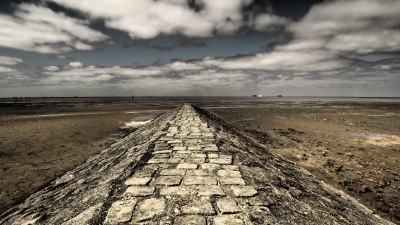How the Roads We Travel Today Were Built on the Stories of the Past
Discover how historical narratives shaped modern roads and infrastructure, linking past innovations to present travel.

The evolution of roadways is a testament to human ingenuity and resilience. From ancient paths forged by feet to modern highways bustling with vehicles, the roads we travel today are built on the foundations of countless stories from our past. Throughout history, roads have not only served as physical connectors of places but also as conduits of culture, commerce, and communication. This article dives into the narratives that have shaped our roads, exploring how ingenuity, necessity, and the spirit of human connection have paved the way for the infrastructure we rely on today.
Ancient Pathways
The story of roads dates back to ancient civilizations. In Mesopotamia, circa 4000 BCE, simple paths emerged as people traversed the land primarily for hunting, gathering, and trade. These paths reflected the geographical and social realities of their creators, serving as essential links for communicating ideas and exchanging goods. As societies grew increasingly complex, so did their needs for more structured transportation networks.
The Romans are famously known for their extensive road systems, constructed for military purposes to facilitate the swift movement of armies across the empire. Using advanced engineering techniques, they built roads that not only connected cities but also became vital trade routes that fostered economic growth. The saying 'All roads lead to Rome' encapsulates the ideological and strategic importance of these thoroughfares, which were meticulously constructed with layers of gravel, paving stones, and careful drainage systems to withstand the test of time.
Medieval Innovations
Following the fall of the Roman Empire, the maintenance of roads declined significantly in Europe during the medieval period. However, the necessity for travel facilitated the use of local pathways, which adopted a more organic style of development. In this era, feudal lords began to build and maintain roads through their territories to ensure the movement of troops and goods. Local trade routes began to flourish, which also saw the rise of market towns that became focal points for commerce.
The Middle Ages were also characterized by the emergence of pilgrimage routes, which often became vital corridors for spiritual journeys. One notable example is the Camino de Santiago, a network of pilgrimage routes leading to Santiago de Compostela in Spain. These roads not only served a religious purpose but also prompted the establishment of inns and local economies, illustrating how cultural factors influenced transportation infrastructure.
The Age of Discovery
The Age of Exploration brought with it new trade routes and an urgent necessity for mustering supplies and connecting distant lands. The maritime routes initially took precedence, but as explorers set out to chart the unknown, overland routes began to see renewed interest. As European powers established colonies around the world, roads were built to connect ports with inland settlements, facilitating the movement of goods like spices, sugar, and tobacco.
In the Americas, roads constructed by Native American tribes were adapted for settler use, leading to the establishment of more expansive road networks as colonization progressed. The concept of manifest destiny in the United States further fueled infrastructure development; investing in roads and railways became synonymous with national growth and progress. Thus, the stories of tragic conflicts and cooperative endeavors shaped the arteries of trade and connection that define modern America.
The Industrial Revolution
The Industrial Revolution transformed transportation like never before, as innovations in technology prompted dramatic changes in how goods and people moved. Roads became crucial in this era, evolving from basic dirt paths to macadamized surfaces that could accommodate larger traffic loads. The introduction of the steam engine led to the construction of railways, forever changing the landscape of mobility.
During this period, turnpike trusts emerged, allowing private companies to collect tolls for road maintenance. This system ensured that roads were better managed, yet it also highlighted the economic inequalities of the time, as wealthier areas benefitted more from improved infrastructures. The need for better transport systems prompted governments to invest in public road networks, setting the stage for the modern highway system.
The Birth of Highways
With the advent of the 20th century, the automobile revolutionized personal and commercial travel. The U.S. highway system began to take shape in the 1920s, leading to significant advancements in road construction techniques and design. Notable projects, like the Lincoln Highway and Route 66, became cultural icons, representing freedom and the American way of life.
As suburbs expanded around metropolitan areas, the importance of road networks grew exponentially. Interstate Highway Act of 1956 marked a pivotal moment in U.S. transportation history, rapidly advancing the construction of interstate highways that spanned the nation. These roads played vital roles during crises, such as mobilizing troops during the Cold War, linking isolated regions, and facilitating commerce on an unprecedented scale.
Technological Advancements
The last few decades have witnessed remarkable advancements in road construction and traffic management, often driven by technological innovation. Modern sensors, traffic cameras, and GPS systems have transformed the roadways into sophisticated networks capable of monitoring and responding to real-time conditions. Smart highways are now being developed, integrating these technologies to enhance safety and efficiency.
Additionally, sustainable practices are influencing the future of road construction. Innovations like permeable pavements, solar roadways, and green bridges are being explored to minimize environmental impact and promote ecological balance. The stories of past ingenuity inspire these initiatives, as we currently build roads that are not only functional but also environmentally conscious.
Cultural Connections
Despite these advancements, it’s important to remember that roads are more than mere physical structures; they are gateways to culture and identity. Every road traveled tells a story—whether it’s about the migration of communities, the march of socio-political movements, or the simple journeys of daily life. The intersections of pathways witness histories unfold, serving as reminders of the diverse narratives that have shaped present society.
For example, Route 66 symbolizes the American road trip culture, while the Silk Road stands as a reminder of ancient trade routes that fostered cross-cultural exchanges. These roads connect not only geographical locations but also human experiences, weaving together the rich tapestry of history.
The Future of Transportation
As we look to the future, the stories of the past will undoubtedly influence the roads we create next. Embracing technological innovations, fostering community connections, and promoting sustainable practices will be imperative for building a transport system that truly serves its purpose in a changing world. The passion to improve the physical and cultural landscape of our roads continues to echo the voices of those who traveled before us.
In the 21st century, electric vehicles, autonomous driving technology, and new transportation models are redefining how we perceive roads and mobility. As cities adapt to these changes, the histories behind the roads we travel will remain vital in informing how we shape future infrastructures. An awareness of our shared stories can guide us toward a sustainable and connected future for all.
In conclusion, the roads we travel today are more than just concrete or asphalt; they are legacies forged from the human experience—each with its own story connecting us to our past. Understanding that roads embody history encourages us to view them as more than just functional constructs but as essential components of our shared journey through time. As we navigate toward the future, we carry those stories with us, shaping the way we build, travel, and connect in an ever-evolving world.











